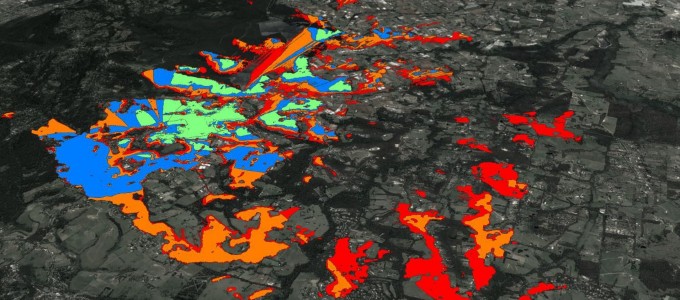Radio Frequency Desktop Modelling and Radio Link Testing

Client: Melbourne Water
Location: Victoria, Australia
Date: 2019 - ongoing
Modelling, mapping and improving the efficiency of wireless communication in real-time telemetry systems
Background
A robust, reliable, high-quality telemetry network requires in-field link testing and accurate desktop modelling of the network coverage. The fundamental task in the design of any telemetry system is to predict the coverage of the proposed network given the location of transmitters, repeaters and gateway or base station. Propagation models are developed to predict signal attenuation or path loss, which can be used to achieve optimum reception from radio field devices.
The mechanisms behind electromagnetic wave propagation are diverse. They are characterized by certain phenomena such as reflection, refraction and diffraction of waves, which can cause signal scattering, fading and shadowing along the signal path. These effects become particularly evident within complex terrain and surrounding structures, with quality wireless communication really relying on the broadcast of waves in free space.
Solution
Entura has been involved with Melbourne Water since 2016, developing and commissioning more than 300 telemetry units that have been fitted to client’s water meters throughout the Yarra Valley. Entura’s capabilities in radio frequency (RF) desktop modelling and the design, installation and testing of real-time telemetry systems has provided Melbourne Water with a purpose-built private radio network for the collection of this data.
Entura modelled large sections of Melbourne Water’s jurisdiction to determine the optimum transmit power, receiver sensitivity, antenna gain, signal to noise ratio (SNR) and signal attenuation of the water data capture devices. This data is typically employed to optimise the placement and quantity of network repeaters and gateways to minimise project costs and establish a list of in-field tests required to refine the model.
The next stage in our RF modelling and testing program is targeted at radio link testing. This uses the modelled terrain, clutter data, radio-specific information, antenna design and antenna height to identify those links that would benefit from in-field testing to lower the level of uncertainty. Entura employs a combination of deployable masts, calibrated RF test equipment and mobile antenna rigs to verify and optimise the location of sites, routers and gateways.
The metering data has been made available to the client through Entura’s Ajenti Data Management System (ADMS) and formatted for ingestion into Melbourne Water’s IT systems.
Services provided
- In-field radio link testing
- RF desktop modelling
- LPWAN systems modelling
Outcome
RF desktop modelling for this project featured comprehensive path design and field-testing for radio links operating in the frequency range from 915 MHz to 928MHz. Our specialist RF testing equipment was utilised in-field to optimise the antenna types, heights and communication paths within the complex terrain of the Yarra Valley region.
Entura’s use of advanced RF communications modelling software and in-field testing techniques has enabled the optimisation of the network’s layout, reducing the number and size of expensive routers and gateway infrastructure. RF desktop modelling is a powerful and effective tool in designing the implementation of an optimized telemetry system, resulting in an overall improvement in the reliability of network communications and reducing total project costs for the client.




